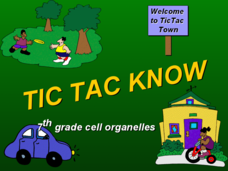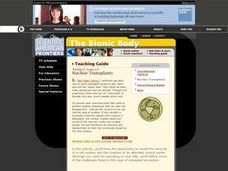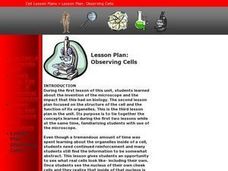Curated OER
Particles: Size Makes All the Difference
High schoolers plot particle sizes of common airborne materials on a log scale. They read an article on particle size and its relationship to the ability to pass through the lungs, into the bloodstream, and eventually into the cells...
Curated OER
Raven Chapter 18 Guided Notes: Control of Gene Expression
So often, genetics worksheets focus on alleles and heredity. Here is one that focuses on the steps of the gene expression process. After reading a textbook chapter or listening to your lecture, AP biology buffs write short answers to...
Curated OER
What Do Genes Look Like?
Seventh graders describe the basic structure of the DNA molecule. They identify what an inherited trait is and how it can be determined by one or more genes. Finally, 7th graders identify that plant and animal cells contain several...
Curated OER
Matching Worksheet: Life Science
In this matching worksheet, learners match fifteen words to their definition. They identify words dealing life science such as cell, cell membrane, producer, and antibodies.
Curated OER
Mitosis
Seventh graders describe the stages of mitosis. In this biology lesson, 7th graders explain the importance of cell division. They complete an activity packet at the end of the lesson.
Curated OER
Mitosis and Meiosis Exercise
In this cell division learning exercise, students answer 13 multiple choice questions based on the process of mitosis and meiosis. Included are questions about the stages of cell division as well as the structures involved.
Community Resources for Science
A Whole New World of DNA and Proteins
Lead your young scientists into an exciting world as they participate in a role play and experiment focused on proteins and DNA. After researching the Central Dogma of Biology, individuals or groups participate in a classroom...
Curated OER
Tic Tac Know: organelles
Tic-Tac-Toe is a game most students will be familiar with. This fun activity prompts students to answer questions about cells organelles in order to place a mark on the grid. There are some non-essential humorous sound effects and...
Curated OER
DNA - The Double Helix
In this DNA worksheet, students read information about DNA and messenger RNA. Then students complete 16 short answer questions and color 2 images.
Curated OER
Internal Systems and Regulation
In this internal systems and regulation worksheet, students correctly decide if given statements are true or false. Students apply information learned about the circulatory system to the given statements to determine statements of truth...
Curated OER
How Genes Work Lesson Plan
High schoolers define the key terms that are the structure and function of DNA. In this genetics lesson students complete a lab activity in which they construct a model DNA structure.
Curated OER
Nuclear Transplants
Students model the removal of a cell nucleus and the insertion of an alternate control center. They define some of the challenges faced in this type of transplant procedure. Students discuss cloning.
National Energy Education Development Project
Introduction to Solar Energy
People have been using solar energy for many generations to dry crops, heat homes, and for light. This presentation explains how now it is possible to capture the solar energy and store it for future use, details how and where...
Curated OER
Life Cycle: Diversity in a Balance 4th Grade Workbook
For this life cycle workbook, 5th graders examine plant and animal cells, classification of organisms, human biology, photosynthesis, and natural environments. 21 different activities make up the Life Cycle Workbook.
Curated OER
Atomic Structure and Bonding
Eighth graders discuss and write about what led up to the discovery of the atom. Students label proton, nucleus, electron, and neutron in their notes. Students take notes on electron shells and how different atoms have different...
Curated OER
Take a Closer Look
For this science worksheet, students complete five sentences about genetics by choosing the correct word from a list. For example, "Inside each cell is one..."
Curated OER
How Do Organisms Reproduce
Students examine the difference between mitosis and meiosis, and describe the steps involved in meiosis and the significance of each step. They create a diploid nucleus containing two pairs of chromosomes using clay.
Curated OER
Cracking the Code of Life
Students examine the concept of DNA. They work together to extract DNA cells from their classmate's cheek. They answer questions related to what to do with their DNA now that they have it.
Curated OER
Sunken Millions Animals
This PowerPoint includes a game with ocean graphics in which two teams answer increasingly difficult questions about animals. Topics covered include plant and animal cells, animal adaptation, and similarities and differences between...
Curated OER
Fertilization to Birth
In this fertilization worksheet, students complete 10 short answer questions about the phases of fertilization then place 6 events of fertilization in the appropriate order on a timeline.
Curated OER
DNA Blueprint for Life
Learners isolate DNA from different food sources. In this biology lesson, students research DNA extraction. They analyze DNA stands collected from the lab, and compare the differences between each.
Cmassengale
Photosynthesis Diagrams Worksheet
Help young botanists get to the root of photosynthesis with this series of worksheets. By completing these diagrams, students demonstrate their understanding of the biological structures and chemical reactions that make this...
Cornell University
Bacteria Take Over and Down
Bacteria outnumber all other forms of life on Earth. Scholars observe the growth of bacteria in petri dishes to understand their role in maintaining good health. Then, they observe the growth of bacteria after they introduce...























